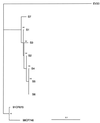Genomic variations in echovirus 30 persistent isolates recovered from a chronically infected immunodeficient child and comparison with the reference strain
- PMID: 10655344
- PMCID: PMC86147
- DOI: 10.1128/JCM.38.2.552-557.2000
Genomic variations in echovirus 30 persistent isolates recovered from a chronically infected immunodeficient child and comparison with the reference strain
Abstract
Seven sequential isolates of echovirus type 30 (EV30) were recovered over 22 months from a child with severe combined immune deficiency syndrome. The nucleotide sequences of the 5' halves of the genomes (4,400 nucleotides) of the first (S1) and last (S7) isolates were determined and compared with that of the EV30 Bastianni reference strain, also determined in this study. In genome regions P1 and P2, 101 variations were identified between the two isolates. Synonymous differences far outnumbered nonsynonymous differences. Amino acid changes affected both capsid and nonstructural polypeptides (particularly 2B). The VP1 nucleotide sequences of the seven isolates were determined to analyze genome evolution during the chronic infection. In the phylogenetic tree, the seven isolates were directly related to the prototype strain in an individual monophyletic group, strongly suggesting that the chronic infection in the child arose from a single persistent EV30 isolate. Four lineages were observed in the persistent isolates. Isolates S2, S4, S5, and S6 were close relatives of one another, whereas isolates S1 and S3 formed individual lineages. Isolate S7, distantly related to all other isolates, formed the fourth lineage. These findings suggest the quasispecies nature of the genomes of the seven sequential EV30 isolates. Grouping of persistent isolates on the basis of replicative capacities was consistent with phylogenetic relationships. Overall, the results indicate that genetically related EV30 variants with different replicative capacities coexisted in a carrier state, probably in the gastrointestinal tract, during the infection of the child.
Figures



References
-
- Aymard M, Chomel J-J, Lina B, Thouvenot D. Annual report 1997. Lyon, France: National Reference Center for Enteroviruses and Hepatitis A; 1997.
-
- Bailly J-L, Chambon M, Peigue-Lafeuille H, Charbonné F. Replication of echovirus type 25 JV4 reference strain and wild type strains in MRC5 cells compared with that of poliovirus type 1. Arch Virol. 1994;137:327–340. - PubMed
-
- Bailly J-L, Borman A M, Peigue-Lafeuille H, Kean K M. Natural isolates of echovirus type 25 with extensive variations in IRES sequences and different translational efficiencies. Virology. 1996;215:83–96. - PubMed
-
- Bello M. Viral meningoencephalitis caused by enterovirus in Cuba from 1990–1995. Rev Argent Microbiol. 1997;29:176–183. - PubMed
Publication types
MeSH terms
Substances
Associated data
- Actions
- Actions
- Actions
- Actions
LinkOut - more resources
Full Text Sources

